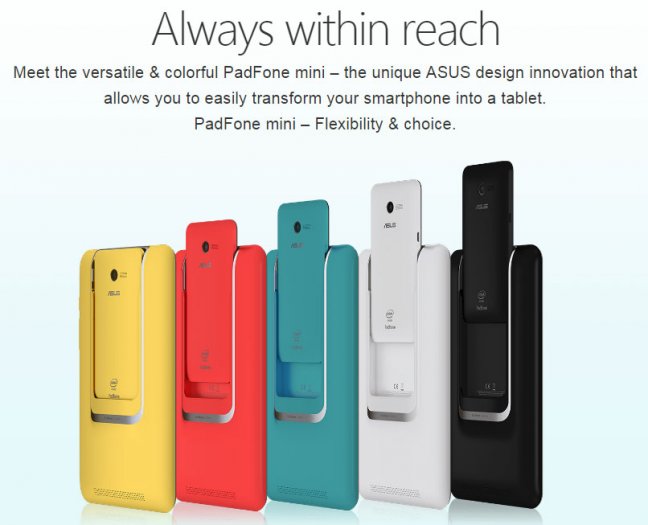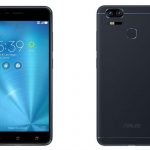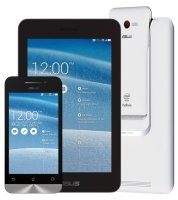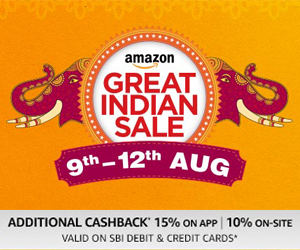Asus PadFone Mini
Score

Asus PadFone Mini Mobile Price in India

Asus is commonly known for its computers but it is now getting famous for manufacturing devices that basically combines two individual gadgets into one unit. PadFone is one of such mach-up by Asus. Asus PadFone Mini is basically the junior version of Asus PadFone tablet having the feature to connect handset directly to it. So the noticeable point here is to have two benefits in single device, a tablet and a smart phone. This is the latest smartphone from Asus in market using the powerful Snapdragon 400 processor and the other using Intel Z2580 processor.
Features and Specifications
The smartphone has an LCD screen which is 4.3-inch large while the tablet has 7-inch large LCD screen. It is powered by 400 Snapdragon 1.4GHz processor along with 1GB RAM each both for smartphone and tablet respectively. It comes with 16GB internal storage and is able to be further extended up to 64GB. It has two cameras as well. The front camera is of 2MP for fallacies while the back camera is of 8MP. The phone weighs 105g which is much lighter while the tablet weight is 310g. The OS it runs on is Android 4.3 Jelly Beans. The battery life for the phone is 1500mAh while for the tablet is 2200mAh and this collectively makes 3700mAh battery. The connectivity features include Bluetooth, Wi-Fi, GPS, micro USB.
Design and Quality
Though the screen size is less as compared to other smartphone but the screen quality and the viewing angles are very nice. Build quality is also perfect. Both the tablet and the smartphone are made up of plastic and together they don’t feel much heavy and can be easily lifted by single hand. The build quality is not that remarkable. The tablet screen gets into working when the smartphone is inserted into it so no big usability issue has been observed. The phone is good looking having beautiful curves.
OS and Tech
The OS offered for Asus PadFone Mini is Android 4.3 Jelly Beans which is though an old OS. It has been promised that Asus will bring ZenUI for its later releases of PadFone Mini. The prototype version of it doesn’t have it but Asus needs to upgrade it to some higher OS or its own ZenUI which will bring its own look to the phone along with few other features. With even this OS, the tablet and smartphone works fine.
Camera and Multimedia
The phone has limitations on camera side. The back camera is 8MP and the front camera is 2MP. So there is no availability of video chat when the PadFone Mini is used as a tablet but the cameras are readily used on phone rather than tablet. The back camera gives usable and relatively fair camera experience. It has autofocus feature which is quite fast and easy to be used and the switching from back to front camera is easy. Under good light, the back camera works fine but under low light, it would be tough to take good quality pictures. The front camera doesn’t perform well at all. In tablet mode, the front camera doesn’t even work. Though front camera is present in the specifications but it doesn’t work as it has to be. The video recording is not fun at all.
Battery and Memory
It comes up with two batteries - 1500mAh for the phone and 2200mAh for the tablet giving a total of 3700mAh battery. Under regular use, the phone battery may last for whole day but under heavy use, this needs recharging. The more of the battery life is being eaten up by the tablet’s large screen. Comparing to its competitors like Nexus 7, the Asus need sot have added more battery to it. The RAM here is 1GB each for the phone and the tablet which collectively makes 2GB but this is less. The internal storage is 16GB which is extended to 64GB but even the 16GB is quite enough memory for the apps to be installed on it.
Pros and Cons
For Pros:
· Good design
· Large screen for both tablet and phone
· Large internal memory
For Cons:
· Old OS
· Less battery
· Poor performing cameras
· Low build quality
Verdict
This is a unique product having embedded smartphone and tablet at better price range. The theme of Asus to remain on the competitive edge from price perspective is a good strategy but this should not be done at the expense of features and specifications. The performance of the phone has been observed compromising over certain features like the OS, the camera, the processor but these can be enhanced in further releases if given proper consideration.
Mobile Specs Analysis to find best models in Price Range of Rs. 11,500 to 14,500.
Asus PadFone Mini Features and Specifications
Latest Asus News










